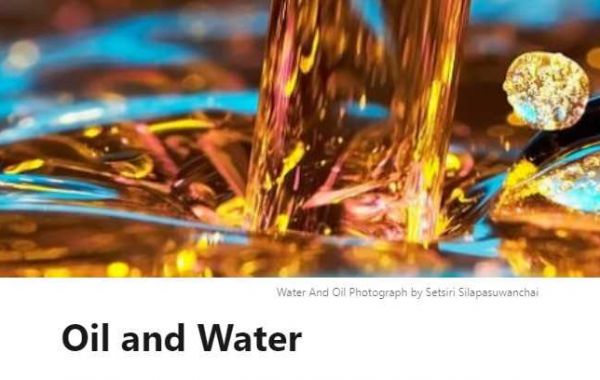In this article I'd like to look at some of the headlines over the last few months, look at the historical price of oil, demand, supply, and then, yes a little "hopium" and what all this might mean. At the bottom of the article you will find a few paragraphs of some additional information, it was researched, but not as catchy . . . there we discuss the numbers. I'm not sure about you but my crystal ball is broken, if I ever had one. Recent events have been tragic for many and for those still working, count yourself fortunate.
OIL ARTICLES
I would like to begin this article with a small bit from a very popular news aggregation, blog and editorial board, Zerohedge.
1. 21 Apr 2020 from ZeroHedge regarding USCF investments ETF USO:
“The entire strip for both WTI- and Brent- Crude are collapsing lower today in unison, because yes, there is nowhere to put the stuff (storage tanks, pipelines, supertankers are all full), but also because market participants believe things won’t be getting much better into the future either, as “nobody needs it,” and without storage since you cannot take physical delivery – then what is the “utility” of the futures contract itself?
And why not throw in a little NN Taleb for good measure:
2. Oil
" . . .The basis is out of whack because of storage. It is like being stuck in traffic in a Bentley, and no possibility of leaving it so you need to pay someone to take it from you. “ NN Taleb
Keep this in mind as we go further into this article. Now in a post earlier in April we noted the extreme volatility in crude price which for many has translated into furloughs, lay offs and reduction in workforce. Recently, regarding oil, a prominent CEO said, “nobody needs it”, please don’t break his heart and tell him that company jet doesn’t fly without fuel!
Background
Editorials like this scare investors and the EP business is risky; nevertheless, we see the effects spreading like a contagion. Anyone with a network on LinkedIn may have noticed many leaders in the industry taking a surprise sabbatical, others being furloughed and “feeling the effects of reduction in force”. So many are out of work in the energy industry, why?
“Nobody needs it,” take that in for a moment and consider that the article speaks of the speculative trades of a commodity that affects each of us. Where I live right now, regular gasoline is only $1.79 / gal at the pump. I know its not the cheapest, but for me that is cheap and . . . I need it.
So Where does some of this information come from that I am going to present? It comes from your tax dollars at work and the link for this and all sourced material is at the bottom of this article. Some of this is from the EIA, or US Energy Information Administration. This is dry material, but often we fail to look deeper into the headlines and really discover what is moving our world around us.
All the same on the shale front we have articles like this, from Desmog:
Fracking Existed Because of Debt, Without New Loans It Can’t Exist
As we have documented on DeSmog, for the past two years the U.S fracking industry has borrowed approximately $250 billion more dollars than it has made selling fracked oil and gas. This has made a lot of fracking CEOs very wealthy and much of that money has also gone to Wall Street bankers — and they won’t be giving it back.
Without the option to borrow more money, the industry will be decimated. In a New York Times op-ed last week journalist Bethany McLean highlighted this reality.
McLean’s book Saudi America highlighted the fatal flaws in the finances of the fracking industry and her current piece sums up the reality of the delusional finances of the fracking industry.
“In reality, the dream was always an illusion, and its collapse was already underway. That’s because oil fracking has never been financially viable,” writes McLean.
The banks know this, which is why they are no longer making loans to shale companies and are taking the last desperate step of seizing oil company assets.
But the banks know one other thing. Banks are first in line for bailouts and there will be plenty of money for them to navigate this issue. The big banks caused the housing crisis by making bad loans — and were bailed out.
The big banks funded the money-losing fracking industry for the past decade just like they funded the housing crisis — but the reality is, just like in the housing crisis, the coming bailouts will protect the banks.
What is different about this crisis is the housing market rebounded and continues on as a large part of the U.S.economy. If people like Jim Cramer are correct and the oil industry is in its “death knell phase” — future funding of the oil industry by these banks may not continue with the reckless abandon that fueled the great American fracking disaster.
Reuters reported that banks are exploring the option of seizing oil company assets .
This was noted in FEBRUARY 2019, let me say that again in FEBRUARY 2019, this was not just a pandemic caused issue, this drop in oil prices in this author’s informed opinion, was and is a result cyclical and historical oversupply. For a perspective on historical oil price per barrel using BLS CPI.
To Summarize
So there it is, while currently (or March, April and May 2020) the large volume commodity traders are shorting this major portion of the world economy, governments are under pressure because of the lowered tax revenue (yes gas is taxed) and you . . . well many of you are out of work with nowhere to go, so what does it matter that gasoline is $1.78/gal unless you are taking those road trips you always dreamed of, the effect is negligible to you isn’t it ( a little sarcasm).
Well there may be a bright side, maybe . . .
WATER, DEEP WATER
If you have made it this far and you are nearly cross eyed from the figures,congratulations, you might have the attention span to not only get back in the work force, but make critical decision based on information presented to you.
ON THE HORIZON
So now lets look at deep water operations, back in 2019 Platts published this piece:
Well, it has been a bit of time since -37 USD per barrel and now of this publish date we are at $24.40 at 1700 Mountain Time on 11 May 2020.
So here is where that comes into play, Deepwater projects are forecasting and this is what they say,
“It is also pursuing what Johnson called "highly economic" brownfield developments at existing fields such as its Jack/St Malo which has produced since 2014 and Shell-operated Perdido, in around 8,000 feet, which has produced since 2010.
Several discoveries are also in early stages of evaluation. Chevron-operated Ballymore, located offshore Louisiana's "big toe," as well as Shell-operated Whale, both made in January 2018, are in appraisal stages to evaluate their respective resource sizes.
Whale is sited 10 miles from the Perdido producing hub, and Blacktip, another Shell-operated discovery made in April and located in 6,200 feet of water, is located 30 miles from the hub. Both are in the remote southern US Gulf.
"We're targeting unit development costs of $16/b to $20/b for the Gulf of Mexico," Johnson said.
One more time that is $16-20/b USD, so we are past that now inside 30 days from the low mentioned at the beginning of our article. Would not investors be chomping at the bit? According to this quote they can get into the black and make profit . . . right?
Conclusion
So what we likely will have is a squeeze, lower supply at a point within the next (a rough forecast) 18 months due to lower production, and hopefully with this current health crisis in check, greater demand. This demand in which both the the onshore and offshore supply shall be lower should boost the price and we will see jobs come back.
Hopefully for many of us involved at any level in the energy market, this will mean not just a return to work, but possibly return to work during another boom time.
Here at our little company in Colorado we hope all is well wherever you are, and thank you for bearing with me through my most heavily researched article to date.
- Zerohedge Article on ETF USO: https://www.zerohedge.com/energy/desperate-scramble-stay-alive-uso-reallocates-oil-holdings-may-invest-other-oil-related
- #RWRI Real World Risk Institute on Twitter, quote by N.N. Taleb: https://threadreaderapp.com/hashtag/RWRI
- Chart regarding fracking is from Rystad, but the article is from Wolf Richter here: https://wolfstreet.com/2020/04/22/u-s-shale-faces-largest-ever-drop-in-fracking-activity/
- You will also find a nice article on energynorthern here: https://energynorthern.com/2020/04/23/us-fracking-set-for-the-biggest-monthly-decline-in-history-as-oil-prices-collapse-and-covid-19-persists/
- Here is a link that will take you into the EIA, All of the math regarding oil, its on the EIA. Here is some of the nitty gritty:https://www.eia.gov/petroleum/
- Thanks to George Bell and Rob Marrs for the great link regarding offshore production here on Energy People: https://www.energypeople.com/news/story/this-could-be-the-beginning-of-a-tremendous-oil-rally
PERSPECTIVE
During the previous peak price back in 1979, the nominal monthly average oil price peaked at $38 per barrel (although the intraday prices spiked much higher).
In nominal terms, we see a fall from $126.33 in June 2008 to $31.04 in February 09 but by June 09 oil is back to $61.46 and by April of 2011 it was back to $102.15. Fortunately, from there it decreased down to $76.90 in September but then started increasing again. The average for the year 2011 was $87.04. 2012 was very close with the nominal average price being $86.46. Crude oil prices rose in 2013 to an average price of $91.17. The first 11 months of 2014 had an average price of $89.08 with a nominal peak in June at $98.18 but December’s sharp drop brought the annual average price down to $85.60. The average nominal price for 2015 was $41.85. So we saw another sharp drop almost as sharp as in 2008.
The common price quoted is the all-time high for Crude Oil prices i.e. the price that the highest barrel ever sold for. That price doesn’t really have any effect on the price consumers paid. What really matters is the average price the refineries had to pay for the whole month.
Interestingly, the highest monthly average price occurred in December 1979 while the highest annual high oil prices occurred in 1980. This means prices spiked higher in late 1979 and then declined slightly but overall remained at higher levels throughout 1980 than they were in 1979.
Adjusted for inflation the 1979 $38 peak oil price is the equivalent of paying $127.81 today. (Note: This number is constantly changing as we adjust for inflation at the current moment.)
A prominent CEO says, “nobody needs it”, please don’t break his heart and tell him that company jet doesn’t fly without fuel!
NICKLES AND DIMES
Here are some figures from the EIA that paint the picture, skip this if you don’t like the nitty gritty, its ok we will summarize further down.
To do the math, just understand that a barrel is 42 gallons and approximately 0.47619 (20/42) of a barrel gets refined into gasoline.
In 2019 the United States produced about 12.232 million barrels per day to produce appx 244.64 billion gallons of gasoline
In 2019, the United States consumed an average of about 20.46 million barrels of petroleum per day OR In 2019, the United States consumed 149.36 billion gallons of gasoline.
In 2019, the United States exported petroleum to about 190 countries. U.S. total petroleum exports averaged about 8.5 MMb/d, which included nearly 3 MMb/d of crude oil, equal to about 35% of total petroleum exports. So about 62.05 billion
The United States imported about 9.10 MMb/d of petroleum in 2019 from about 90 countries, which included 6.8 MMb/d of crude oil and 2.3 MMb/d of noncrude petroleum liquids and refined petroleum products. This was the lowest level of total petroleum imports since 1996.
So we net imported 3.8 Mmb/d of crude, alright so that s a possible extra 27.74 billion gallons of gasoline
lets do some math
produce appx 244.64 billion
extra 27.74 billion gallons
so throughout the year in 2019 there was appx 272.38 billion gallons of refined gasoline available
now remember in 2019 we CONSUMED in all 149.36 billion leaving
Officially 123 billion gallons of gas available, here in the United States we only used 55%!
TAXES
So here is a chart from The American Petroleum Institute, that tells you dear reader, what the tax is on gasoline in your state, and remember the Federal Government issues an $0.18 excise tax as well.
OF that 272.38 billion gallons of gas, 48.1614 billion gallons is used by the reported 127.98 million full time workers so approximately 20% of the gas is used by the reported full time workers.
So these are the numbers, now here is what might really get you fired up, while you are unemployed. In a gallon of gas, here is what the taxes and fees are to federal and state combined:
Texas = $0.38
Colorado = $0.40
Pensylvania = 0.767
California = $0.792
Just think about that, so lets say on average, for this article’s sake , lets propose a State makes 28 cents a gallon and the federal government 18 cents on excise tax.
So here you go
All the States combined at 0.28 USD are 41.82 billion, divide by 50 and per state you get $836.4 million, almost $1,000,000,000 billion in gas tax revenue per state, per YEAR.
The federal Government is making $26,880,000,000 billion A YEAR from people doing the following:
going to work
picking up children from daycare
going to school
doing errands













